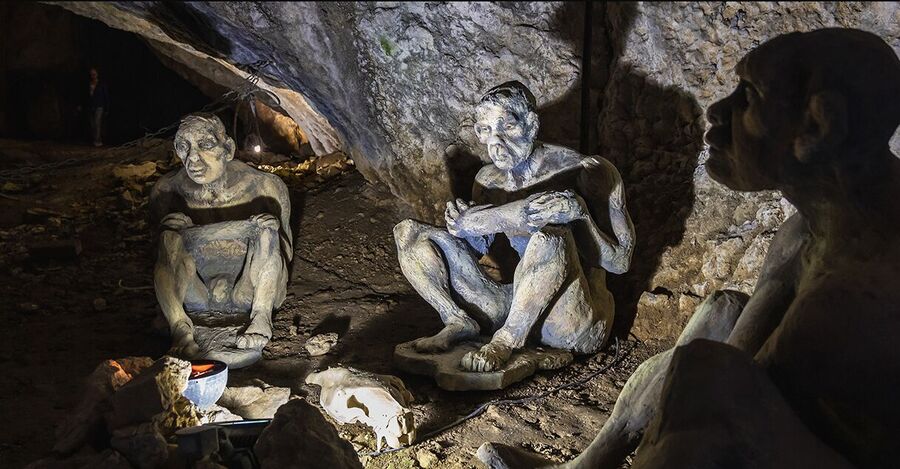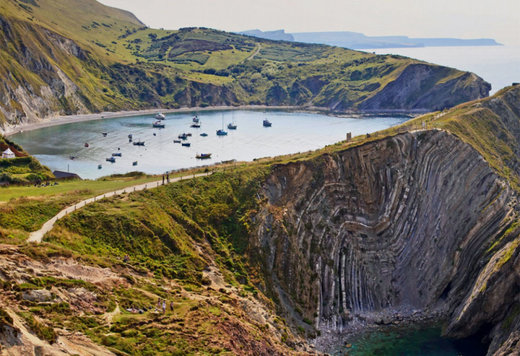
Some 45,000 years ago, Bulgaria's Bacho Kiro caves hosted modern humans — depicted here in sculpture — whose genomes suggest they had recent Neanderthal ancestry.
The findings — released last week as a bioRxiv preprint that has yet to undergo peer review — sharpen the timeline for this critical and mysterious juncture in human history. It's the first paper to use dozens of ancient Homo sapiens genomes to address this question, and it may have implications for the timing of other major events in human evolution, such as the peopling of Australia.
"I found it quite convincing," says Rajiv McCoy, a computational geneticist who studies human evolution at Johns Hopkins University. "It's probably the most comprehensive picture we have to date of Neanderthal gene flow into modern human populations."
Neanderthals and modern humans diverged perhaps 500,000 years ago, with Neanderthals concentrated in Eurasia and modern humans — our H. sapiens ancestors — in Africa.
Comment: Evidence suggests that not all H. sapiens emerged 'Out of Africa': Most human origins theories are not compatible with known fossils
Then, modern human groups ancestral to all non-Africans today left the continent sometime about 70,000 years ago and spread out across Eurasia, likely encountering Neanderthals in what today is the Middle East or in Europe.
Couplings between the two groups of humans may go way back, to 100,000 years ago or earlier, when some modern human pioneers took tentative journeys beyond Africa. But not all the inherited Neanderthal DNA from those early encounters survives in people today. Much was lost over time because of natural selection, chance, or lineages simply dying out.
Analyzing ancient samples from modern humans, and tracing how they gained and lost Neanderthal genes over time, would tell a more complete evolutionary story about the origin of the Neanderthal genes that persist today.
To do that, Priya Moorjani, a population geneticist at the University of California, Berkeley, and colleagues analyzed previously sequenced genomes from 59 ancient H. sapiens, mostly from Western Europe and Asia, dating from between 45,000 and 2200 years ago. The oldest included DNA from Ust'-Ishim man in western Siberia (45,000 years old), the Czech Republic's Zlatý kůň woman (45,000 years old), and individuals from Bulgaria's Bacho Kiro caves (35,000 to 45,000 years old) and Romania's Peștera cu Oase caves (40,000 years old).
The researchers next identified regions of Neanderthal DNA in these ancient modern human genomes and in genomes from 275 present-day individuals from around the globe. Then, they used computer software to track the evolution of Neanderthal genes over time across the various ancient and recent populations, estimating approximately how many generations would be needed for the genomes to subtly diverge the way they did. Because the team included the ancient H. sapiens genomes, their analysis reached a level of precision that simply wasn't possible in earlier studies based primarily on contemporary genomes, McCoy notes.
Moorjani and colleagues conclude in the preprint that Neanderthal genes began flowing into the ancestors of people alive today about 47,000 years ago. Modeling shorter and longer periods of gene flow, they found that a scenario in which Neanderthals and modern humans exchanged genes over a period of about 6000 to 7000 years best fit the data.
The preprint doesn't discuss how often Neanderthal and modern couples got together over that stretch of time. But such pairings likely weren't rare, says Fernando Villanea, a population geneticist at the University of Colorado Boulder who studies Neanderthal-human admixture and wasn't involved in the study. For example, the oldest individuals from Oase and Bacho Kiro both show very recent Neanderthal ancestry, within a dozen or so generations, Villanea notes. They, along with other H. sapiens individuals older than 40,000 years, carried some segments of Neanderthal DNA that aren't found in modern populations. That suggests their ancestors may have had additional encounters with Neanderthals, but their lineage died out without leaving any known living descendants.
"Clearly, humans were running into Neanderthals all over the place," Villanea says. "Maybe some of these early interactions were in populations that didn't leave descendants, but then [about 47,000 years ago] there's this main event. That makes a lot of sense."
The very oldest genomes from modern humans held relatively long stretches of Neanderthal DNA. But in genomes just a few thousand years later, the Neanderthal segments were much shorter. That suggests modern humans quickly rid themselves of some of these early, long stretches of Neanderthal DNA, which may have carried deleterious mutations or led to infertile offspring.
Comment: Another study adds:
"Interbreeding at this time may have been the result of mutual courtship or could have been less friendly. [...] The lack of mitochondrial DNA, which is inherited through females, from Neanderthals in living humans has been suggested as evidence that only male Neanderthals and female Homo sapiens could mate, but there is also some evidence that male hybrids may have been less fertile than females.
At the same time, the study confirmed that modern humans acquired several Neanderthal genes, involved in skin pigmentation, immune response, and metabolism, that ended up being advantageous to our lineage.
The findings suggest that during the early days of this gene flow — wherever it occurred — roughly 5% of the interbreeding population's genes came from Neanderthals, Villanea says. "That means one in 20 individuals in this population that ended up being ancestral to all [people outside of Africa] was a Neanderthal."
The date of these matings helps pin down the timing of other major migration events, such as when H. sapiens arrived in Australia, says Chris Stringer, an anthropologist who studies human evolution at the Natural History Museum in London. Indigenous Australians today carry the same Neanderthal ancestry as all other non-African populations. So, their ancestors must have reached Australia after this mixing event, no earlier than 47,000 years ago, notes Stringer, who wasn't involved with the new study.
That conflicts with some estimates based on archaeological evidence — such as the Madjedbebe 2 rock shelter, purported by some to be 65,000 years old — that put modern humans in Australia much earlier. "The implication," Stringer says, "is that those early dispersals either went extinct or were effectively replaced or swamped by larger later waves."
If so, those ancient humans were in good company, Villanea says. "Ultimately, most ancient human groups did not leave descendants." The new analysis helps track the few who did.
doi: 10.1126/science.zf18669



The Why Files, put this out. Seems more like what happened...